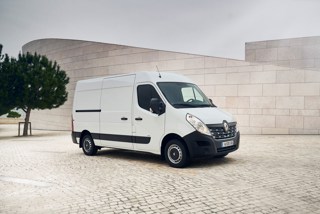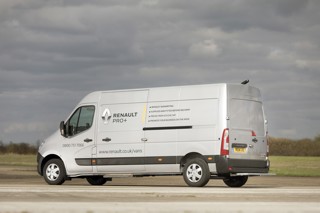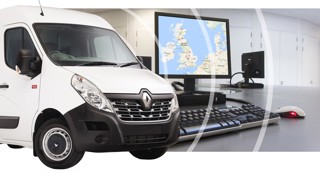Review
December 2018 - final test
The time has finally come to send our dashing Renault Trafic back to its maker, having served us faithfully and reliably for the past six months or so.
Years ago when running long termers, we invariably reported a catalogue of mishaps, disasters and breakdowns. But, nowadays technology has advanced at such a rate that very rarely does anything go wrong – a huge boost, of course, both financially and logistically, for any fleet operator.
Our Renault goes back with a clean bill of health and a great big tick in the “wow” box from us, because this particular Trafic is rather special – it’s the Formula Edition, loaded with bling and extra stuff you don’t usually get on a commercial vehicle.
Funnily enough, the engine is exactly the same as the one in lesser models, pumping out 145PS and 340Nm of torque.
But, in our book, that’s plenty of oomph for a van and we have not once found this vehicle lacking in the power department.
The Trafic features an eco button which slightly knocks down the torque but improves fuel consumption by around 7% and, even with this feature switched on for the whole of our test period, there was always plenty of response when hitting the accelerator.
This model certainly isn’t cheap at £32,210 (ex-VAT) but if you want to get noticed, I can’t think of a better way of doing so.
Obviously, our test model came without signage but, with a company logo attached, everyone will look at it – and read whatever message happens to be emblazoned in the side at the same time.
The Trafic has notched up just more than 7,000 miles while with us and many of those miles have been long distance journeys from Southend to Devon – a trip of some six hours and 300 miles.
With a short break halfway, both my wife and I invariably arrive at our destination feeling fresh and without any sign of back twinges.
But the Trafic has not only been a dazzling looker – it’s hugely practical, too. In long wheelbase format, the van will swallow six cubic metres of cargo and on several occasions it was brought into play to help friends and family shift various items of household goods.
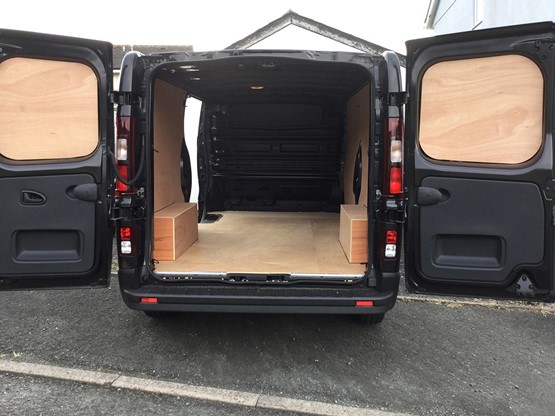
Luckily, it is full plylined so, despite some pretty grubby work, Renault will be able to pull off the various bits of wood and reveal a still shiny interior before the van is finally sold.
The niggles are few and far between. But, if I have to be ultra-picky, one problem is that the side pockets in the doors are virtually impossible to get at while on the move.
So, if you put a box of tissues there for use while driving along, you probably won’t be able to get it out again when you need it.
The other is that the mobile phone holder on top of the dash isn’t big enough to hold many of today’s smartphones. Those two gripes apart, this van has constantly surprised and pleased me, both with its superb comfort and its impeccable driving manners on the road.
In fact, I’d go as far as to say that were I to buy a medium panel van for myself, this is probably the one I would choose – although my purse would stretch only to one of the lesser models, admittedly.
That honest assertion should prove a massive pat on the back for Renault.
November 2018
Our stunning Renault Trafic has been with us for nearly six months now, which has given us ample time to weigh up and assess its cost-efficiency in the fuel department.
We haven’t mentioned fuel economy in any detail as yet, purely because my usage of the vehicle is so erratic – one week it’s all long distance journeys and the next a lot of round-town excursions – that we have to average it all out over a few months rather than days or weeks to give a fair assessment.
Our van is a sporty one, as can be seen from the picture, so it’s all too easy to drive in an ‘enthusiastic’ manner. Luckily for me, the Trafic has a little button on the dash that slightly cuts down the torque and promises up to 7% savings on diesel, so I’ve kept it pressed in all the time.
The van did seem slightly sluggish when I first tried the device but after an hour or two I didn’t even notice the difference. Even ascending some steep hills hasn’t resulted in the need for that extra little bit of oomph.
The official figure on the combined cycle is 46.3 mpg, but, as we all know, this figure is calibrated on a rolling road so fails to take into account either cargo weight or wind resistance, thus is unlikely to be replicated in real life.
Renault will be pleased to learn that with some judicious light-footing on my part, our overall figure so far is 45.6mpg. Given we reckon an average driver will score around 10-15% less than the official figure on a good day, we are pretty pleased with our tally.
Having said that, technology marches on at a spectacular pace and the Trafic fares badly in fuel economy terms against the newer Citroën Dispatch/Peugeot Expert rivals.
The Dispatch extra long 150PS model, about the nearest rival to our Trafic from the PSA Group, claims a staggering 53.3mpg on the combined cycle.
That means that if both vans actually achieved the figures stated on the tin, the Dispatch would use £375 worth of diesel less at today’s prices compared to our Trafic over a 100,000-mile lifecycle.
Meanwhile, the rival Volkswagen Transporter long wheelbase Highline variant with 150PS on tap offers 47.1mpg on the combined cycle, still nudging ahead of our Trafic, while the Ford Transit Custom Sport 170PS lags behind at 42.8mpg.
Quite how the PSA contender manages to squeeze so much out of a gallon of diesel is something of a mystery, but maybe the rivals should start investigating.
It looks as though the price of fuel is rising again so van fleet operators will be keeping a beady eye on official fuel economy figures when those all-important buying decisions are being made.
As the months go by, I am still discovering little extras I hadn’t noticed before, this van being awash with non-standard goodies. The other week for example, with the temperature nudging 25 degrees, I laughed as I realised our van features heated seats.
Our test period ends next month, so I doubt if we will be making use of this facility, but it does go to show just how many bangs you get for your buck with this model.
We’ll certainly be sad to see the back of it, as it is about the most striking van we’ve ever had on test at Commercial Fleet magazine.
October 2018
A discussion arose among the journalists at Commercial Fleet the other day about which vehicles we should be testing and which were more appropriate to leave to other other titles.
This question arose largely because the long-term Renault Trafic we have on trial is not exactly what you would call a fleet model. In fact, it’s about as far away as you can imagine. Should we have chosen a “fleetier” variant?
My answer was to point out we didn’t actually know which model Renault was going to send us until it arrived at our offices. In addition, I would contend that there are a few instances where I can imagine this van fitting nicely into a fleet scenario.
The business world is changing and with more vans on the road helping UK plc to run smoothly every year, many firms are realising a van is more than just a donkey for lugging loads around.
Some high profile fleets – such as, say, local businesses or tech firms that want to cut a dash on the high street – will certainly do just that with this model.
And don’t forget that if the general public are looking at the van, they will also be looking at any company logos on the side.
Also, a van like this can be used as a carrot to improve the fuel economy of a fleet. The plan goes like this – the company buys 50 ordinary Trafics and one Formula version.
A little competition is set up among the drivers to see who returns the best fuel economy – this figure being available courtesy of the firm’s onboard telematics system. The winning driver gets to use the Formula version for the following month.
Don’t scoff at such a scheme. We know from the experience of some of our more enlightened readers that it works – and can save thousands of pounds a year in fuel, thus recouping the extra cost of the van and more.
Whatever the rights and wrongs of testing this van for six months, I am enjoying the experience in the extreme.
I’ve always said the Trafic is about the best van on the roads today for the actual driving experience and to be honest I’m a bit of a show-off at heart and enjoy the admiring looks and stares I’m getting when stopping at traffic lights and junctions.
My partner has some health issues to contend with and she found long journeys in our last long-termer, a VW Caddy, a trial because she couldn’t stretch out far enough.
But once I have got her up into the Trafic, there are no such problems and the seven-hour drive from Essex to our holiday home in Devon is a much more comfortable experience.
This van, despite all its exterior bling, also has a practical side too.
It’s a long wheelbase variant for starters, which ups the loadspace from 5.0 cubic metres in the SWB model to a useful 6.0 cubic metres – and the rear of the van is fully ply-lined, so even with dirty loads, the wood panelling can be removed at selling time to reveal a pristine cargo area.
This could add hundreds of pounds to the sale price of the vehicle so is well worth doing.
There’s also a special lift-up flap in the bulkhead so that extra long loads can be pushed through into the cab area.
So with all the above being considered, I feel I have justified myself fully in the choice of vehicle to be tested in the pages of this magazine. If readers have any views on the subject, we’d be interested to hear them.
September 2018
Living by the seaside has many benefits – a free dip on a hot day without having to drive anywhere, bracing beach walks on cold days and myriad good seafood restaurants spring to mind immediately.
But there are drawbacks, too – and one of the biggest is the presence of thousands of herring gulls.
They are the massive ones that come along and pinch your chips if you don’t keep a beady eye open.
Bearing in mind what they eat, it is not hard to imagine the volumes of guano they produce and the local flock seems to have taken an unwanted interest in my shiny black van.
In fact, on a couple of occasions, it has more resembled a piece of abstract art rather than a commercial vehicle.
Even the presence of several neighbouring cats doesn’t put them off, as the birds simply imitate a squadron of Lancaster bombers delivering their ‘deadly’ loads.
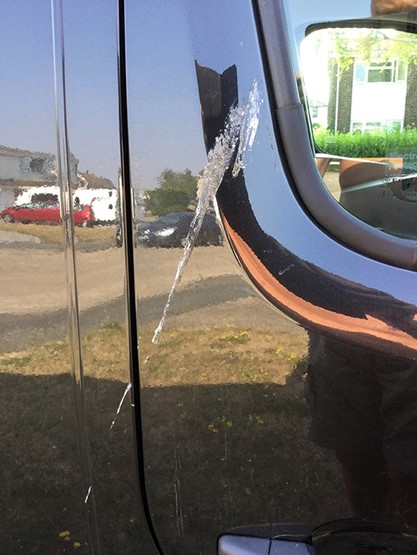
Joking apart, a van can be visually trashed in a couple of hours when parked round here and, of course, pitching up at a client’s premises in a vehicle covered in guano is not going to do a lot for the credibility of the firm that owns it.
I’ve spoken to several business people round my way who are constantly having to valet their vehicles, adding to the day-to-day running costs of the fleet.
You can’t take a big van through an automatic car wash and those people who stand around in supermarket car parks with cloths and buckets won’t touch them either.
Luckily I have found a guy in my local independent garage round the corner who will do the job for £30 but if you have to have it done every week, that adds up to £6,240 over the course of a four-year fleet lifecycle.
Bearing in mind that many companies keeping a tight control on finances for cash, this problem on, say, a 100-vehicle fleet could be a major one.
On a happier note the importance of air-conditioning has been brought home to me fully in the August heatwave.
I had to drive my camper van on the six-hour trek to my holiday home in Devon recently and, as my own vehicle doesn’t have air-con, I ended up soaked in sweat, with my head thrumming from the noise of the wind coming in through the open sidescreens. How grateful I was to climb back into the cool, calm climate-controlled cab of the Trafic.
I took some time to study other van drivers on the motorway and you could clearly see which ones had air-con and which ones didn’t – and I felt sorry for the poor souls sweating their way through a working day in such conditions.
And it’s not just pity because surely those guys and gals are much more at risk of causing an accident having to drive in that heat.
So, my message to any fleet manager who thinks air-con represents an unnecessary cost is – think again.
The £400 or so per van this little ‘luxury’ costs will pale against the sums incurred in the event of a sweat-induced smash.
August 2018
No sooner had I typed the words “this van ticks every box for me” and opined that the Trafic had zero minus points about it than I was cussing and swearing over our poor hard-pressed long-termer.
This ‘fault’ is not exclusive to the Trafic – indeed most vans are guilty of it – but why, oh why, can’t the various manufacturers do something to alleviate it?
This particular niggle involves my reading glasses and the van’s seat. I rather stupidly placed my specs on the passenger seat and, as soon as I went round a bend, they whizzed off and located themselves somewhere in the murky depths of the cab where I had never even looked before.
Try as I might I couldn’t even see them until I had pushed the driver’s seat as far forward as it would go and there they were, nestled in a hollow wedged between two bits of metal.
My wife managed to move them after about 10 minutes of trying, just enough for me to hook them up with a knife.
I’m sure I’m not alone when I relate this tale of woe, so my question to all van manufacturers is this – why do there have to be so many unreachable little nooks and crannies under a van’s seats?
A more serious incident of note occurred the other day – and one which left me realising just how important the modern technology we get on vans nowadays really is.
After buying some goods at a local supermarket, I climbed into the van, switched the engine on, put the gear lever in reverse and immediately the reversing bleepers told me something was amiss.
I had been about to back up as I couldn’t see anything in the rear view mirrors but a glance at the reversing camera screen on the dash revealed a girl aged about 14 chatting to her mate on her mobile, oblivious of the fact that my reversing lights were on and I had almost backed into her. She was hidden from my line of sight.
I got out of the van and tried as politely as I could to explain the folly of her ways, but, sad to say, instead of a red-faced apology to yours truly, I was treated to a mouthful of abuse.
The girl may not have learned a lesson here, but I surely did. Always trust your onboard technology.
Of course, the problem with rearward cameras and sensors is that the fleet manager can struggle to assess their true value.
A driver is hardly likely to go to the boss at the end of the day’s work and admit he almost backed into a lady with a pram or, indeed, a concrete post.
If these sensors are not a standard fitting, then they should be the first thing to be added on the list of extras. They will pay for themselves time and time again, believe me.
I made it a crusade during my time as editor of our previous incarnation Fleet Van to call for reversing sensors to be made a legal fitment on all commercial vehicles.
It would be an easy law to enact but sadly, as of today, no such legislation seems to be on the horizon. As I am now past retiring age, maybe my younger colleagues could take up the cudgels where I left off.
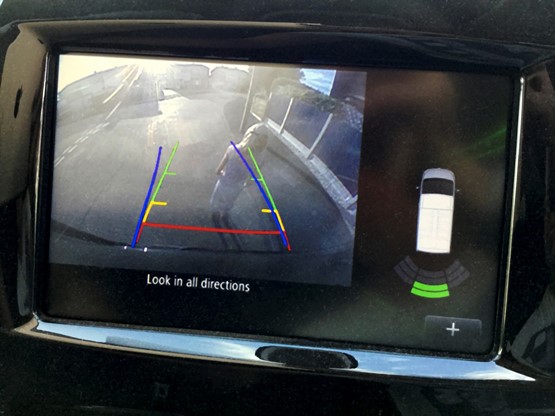
July 2018
As we approach the halfway point of our six-month test in the Renault Trafic, I am settling down to a pleasant life with this bobby dazzler.
By now, I am well used to all the admiring (and sometimes jealous) stares from other van drivers and am immensely enjoying using all the gizmos and gadgets that accompany it.
By this stage on a test, I have usually found a few gripes and moans, but, to be honest, I am struggling to find anything negative to say about the Trafic. It just about ticks every box.
We need not say anything more about the van’s exterior. But inside the cab there’s plenty to talk about.
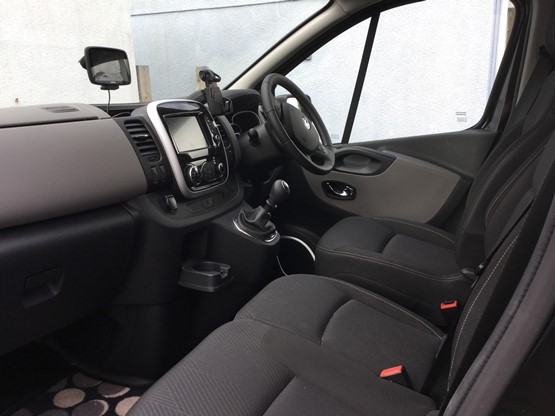
The seat – a non-standard one – is wonderfully comfortable and supportive, with a lumbar adjustment that helps an old groaner like me avoid back twinges on long journeys.
When the Trafic was last upgraded in 2014, Renault dropped the seat height by 40mm to give the van a more car-like feel to drive.
I quite liked the old sit-up-and-beg van driving style so I have the seat adjusted way up high with the back in an upright position.
Suffice to say on a seven-hour trip from my home down to our holiday place recently, I did not suffer one backache.
The R-Link system in the centre console seems to do just about everything but cook me a cheeseburger and fries and there’s even a clip to hold my mobile phone.
In addition, we get a USB port on top of the dash so I can plug my own TomTom unit in without having wires trailing all over the shop.
The van has its own sat-nav system but all my details and destinations are on my personal unit, so I still use that one.
My wife was delighted to find a massive ‘vanity’ mirror on the passenger side and was happily preening herself before I pointed out that it was, in fact, a special safety mirror which allows the driver to see down the nearside of the vehicle.
It is a neat and cost-effective little solution to a potentially serious problem.
In long wheelbase format, this van offers six cubic metres of cargo space and you’d be amazed how much you can pack in.
The full ply-lining meant that heavier bits and pieces could be slid in easily without catching on the metal ribs of the floor.
Under way, this van really is a dream to drive. Gears slip into place smoothly, corners are taken with the utmost aplomb and with 147PS under the bonnet from the perky little 1.6-litre turbodiesel unit, it is never lacking in oomph.
If six cubic metres of cargo space isn’t enough then the rival Citroën Dispatch XL, costing £26,115 ex-VAT, offers 6.6 cubic metres while the Volkswagen Transporter LWB hi-roof, at £26,475 ex-VAT, has a whopping 9.3 cubic metres. Both have 155PS on tap and the Transporter returns 43.5mpg on the combined cycle to the Trafic’s 46.3mpg, while the Dispatch trumps both at an admirable 53.3mpg.
The Trafic arrived with just delivery mileage on the clock, but fuel economy is rising slowly as the weeks pass.
There’s little button on the dash which slightly knocks the power down but can add up to 15% on fuel economy so we keep this pressed firmly in.
So far, much of our mileage has been long-haul stuff, which means the stop-start system doesn’t get to work very often.
With a few more round-town trips we reckon we could well achieve the stated 46.3mpg figure by the end of the test.
June 2018
The yellow is not so mellow on this attention-grabbing van that looks fit to carry TV’s The A Team, Trevor Gehlcken's long-term update reveals.
Not since the day when an 8.5-litre V10 Dodge Ram turned up at our offices back in 2007 has a test vehicle caused such a stir.
As can be seen here, our latest long-termer, the Renault Trafic Formula Edition, looks more like transport for The A Team than for your average delivery driver.
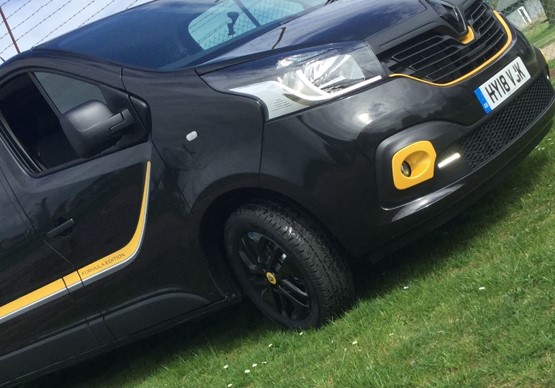
When pitching up at the car park, I have been the subject of various jealous looks from the staff of other magazines that share our headquarters. Meanwhile at home, many of my neighbours have stopped to admire and comment on this little bobby dazzler – and I caught one guy actually taking a photograph of it.
The other day an Amazon delivery driver brought a parcel and asked if the van was a one-off, customised model. When I informed him he could actually buy one like it from the local Renault dealer, he seemed staggered (and envious).
The price is, as one might expect, high. You can get a standard Trafic for a tad in excess of £20,000 (ex-VAT) but once all the bling and technology is added – and in long wheelbase format – our test van comes in at £32,210 (ex-VAT).
Yes, we know most fleets won’t choose this model, but at least it gives us the chance to play with all the accessories available and give our judgement on their merits (or otherwise) for fleet buyers.
If we listed all the goodies on this van, it would take up a lot of space so we’ll just mention a few of the stand-out ones for the time being. We have another four months to talk about the others.
Outside, this van screams “look at me!” with gaudy yellow stripes down the sides, yellow foglight surrounds, a sparkly black paint job and black alloy wheels.
In the cab, we get special sporty seats with lumbar adjustment, a leather steering wheel, a fold-down little desk in the middle seat back, a ‘Luxe’ pack which adds all kinds of bling and silvery bits to the cab and even a cradle for the mobile phone.
On the safety front, there are all the usual bits and pieces which are now a legal requirement, plus reversing sensors, a reversing camera and cruise control.
That said, Renault doesn’t offer the city automatic crash protection system that slams on the anchors in the event of a likely crash which is now standard on the rival Volkswagen Transporter.
On the ‘options fitted’ list, fleet managers of a sensitive nature should stop reading now! We have climate control at £1,200 (are they kidding?), ply-lining at £630 (essential), passenger and curtain airbags at £660, rear parking camera at £250 (well worth it), and Renault’s R-Link Multi-Media system at £775.
Under the bonnet goes a rather diminutive 1.6-litre turbo-diesel engine which pumps out a nonetheless meaty 145PS, plenty of power to move this van along nicely yet not too ‘loony tunes’ for fleets.
The official combined fuel economy figure is a pleasing 46.3mpg.
Given much of my driving is on motorways, it will be interesting to see whether we can get anywhere near the official figure.
Our test figure of 39.8mpg is a little askew as the engine is new and has yet to loosen up so we’ll be keeping you updated on fuel economy as the months pass.
May 2018 - first test
Our long term "far from ordinary" Renault Trafic is weighted down with bling and accessories that most fleet drivers can only dream about. By Trevor Gehlcken
It seems like only yesterday but it was, in fact, 17 years ago that I joined a party of UK van journalists flying to Copenhagen to drive the new Renault Trafic for the first time.
There was a buzz among us that this van was going to be a bit special and, indeed, we weren’t disappointed.
First glimpse of the new vehicle showed it to be so different as almost to be described as space age, with a curious bump in the roof and dashing lines that made it look different from any other van on the road.
Getting behind the wheel for the first time, we soon discovered that beauty was more than skin deep – this was the first panel van to actually drive like a big car.
In a nutshell, I came back to the offices of our predecessor title Fleet Van raving about the new vehicle. And over the ensuing 17 years, my respect for it – far from waning over time – has grown.
At launch, there was just one wheelbase and one engine – a 1.9-litre unit – available.
Since, there have been long wheelbase and high roof variants introduced, along with one major relaunch and any number of nips and tucks, keeping the Trafic right up with the leaders in the field.
It has also become one of the most ubiquitous commercial vehicles on the roads today, as it is rebadged as the Vauxhall Vivaro, Nissan NV300 and more recently the Fiat Talento
Despite this, the van is, at heart, a Renault and when the press office at the French manufacturer called to ask if we’d like a Trafic on long-term test for six months, we didn’t hesitate to accept the offer.
Whether you choose a Renault, Vauxhall, Nissan or Fiat is a matter of individual choice.
While the Vauxhall is built at Luton using many UK-sourced parts, the others mainly hail from France.
Renault, meanwhile, offers a network of Pro+ centres for fleet buyers, which may well sway the buying decision in its favour, with extended opening hours, 24-hour repair booking and specialist advisers on tap.
Of course, now that the PSA Group has bought Vauxhall and has committed to building a brand new Vivaro at the plant from next year, our guess is that this new model will be a replica of the present Citroën Dispatch/Peugeot Expert, although no official news has emerged yet.
What a tangled web the van manufacturing industry is at present!
When we are offered vehicles to test from the various manufacturers, we never quite know what actual model is going to turn up.
In this case, we were expecting the usual run-of-the-mill fleet-type Trafic and were stunned when this little humdinger pitched up.
A glance at the pictures shows this Trafic is about as far from ordinary as is possible to get – weighted down with bling and accessories that most fleet drivers can only dream about.
But, at least, it will give us a chance to put all those extras to the test and recommend to our readers which ought to be specified at fleet buying time and which can safely be left out.
Suffice to say I’m relishing the thought of using this van for the next six months – and there is likely to be a queue of car testers from sister title Fleet News wanting to try it out, too, something that rarely happens when we get commercial vehicles on trial.
Model tested: Renault Trafic ll29 dci 145 formula edition



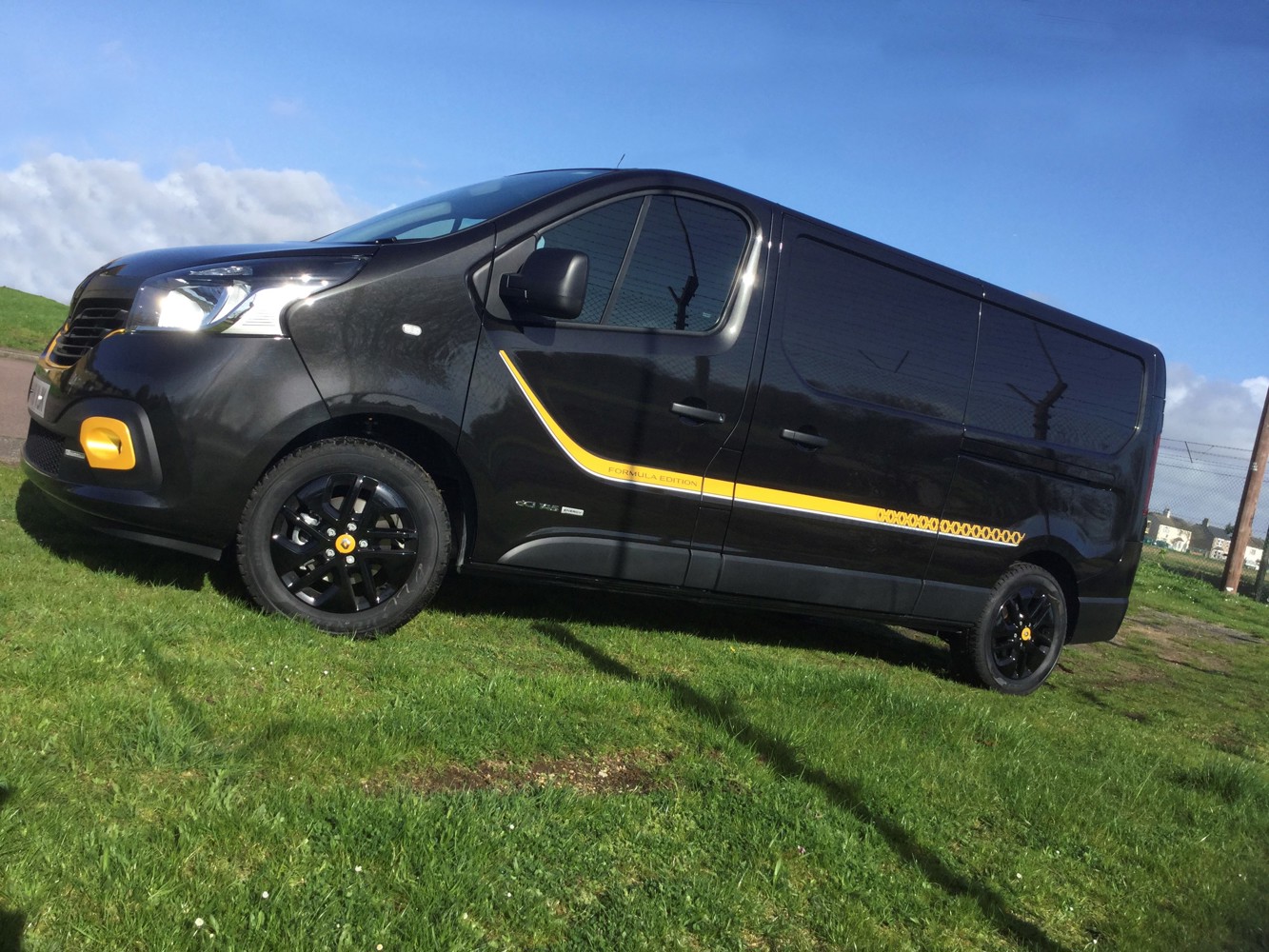
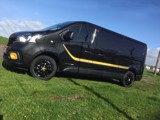
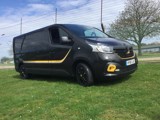
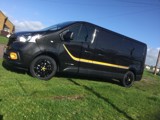
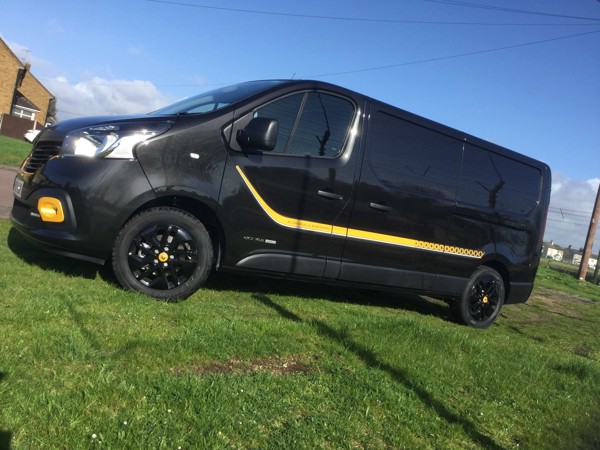
 Diesel
Diesel













